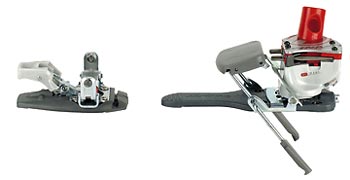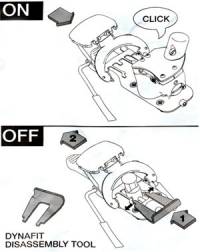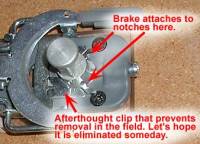Shop for Dynafit backcountry skiing bindings
What is this FAQ about?
All Dynafit backcountry skiing binding models function nearly the the same way and are very similar. For CURRENT information about Dynafit bindings, SEE THIS FAQ. For information specific to the Comfort model released in 2004, you are in the right place. Some of the information below (such as weights) is duplicated in all our Dynafit FAQs here at WildSnow.com. Also know that most of this information applies to the Vertical FT and ST models, which are basically the same binding as the Comfort.

2003/2004 Dynafit Comfort binding
Short version of what the Dynafit Comfort Binding is?
For a couple of seasons (circa 2002) Dynafit sold a binding called the Tri-Step. It had an improved heel unit but the toe had problems. Many backcountry skiers soon discovered that the Tri-Step heel could be used when combined with the TLT toe on a riser, to create a rig that gave the best of both models. For the winter of 2003/2004 Dynafit made this mod official, discontinued the Tri-Step, and began selling the Comfort, which uses the Tri-Step heel mated with a slightly changed TLT toe.
Do Tri-Step bindings work?
Please be advised that while the Comfort and all later Dynafit bindings are better products than the Tri-Step for backcountry skiing, the last production model of the Tri-Step (around 2002) is a functional binding. Test on workbench with your boots, try in touring mode with boot flexed forward to check how the boot toe interacts with the binding.
What are the main differences between the Comfort, TLT and other Dynafit models?
The Comfort and all other Dynafit bindings through 2015 are similar in a mechanical sense. The Comfort binding raises your foot higher off the ski than previous models. The Comfort heel is easier to rotate with a ski pole to change the height of the climbing post. The heel has longer pins that insert in the slots in the heel of the boot, resulting in slightly better downhill ski performance. The Comfort heel unit adjusts for and aft for a wide range of boot sizes; about three, while the TLT only adjusts about one size. When in the open position the Comfort toe pivots are closer together than those of the TLT, ostensibly to make the binding easier to clip into. The Comfort weighs a few ounces more than the TLT, and costs more.
How much do Dynafit bindings weigh?
Comfort toe and heel unit combined: 13.5 ounces, 384 grams, no screws, no brake.
Comfort toe unit: 5.3 ounces, 152 grams.
Comfort heel unit: 8.2 ounces, 232 grams.
Comfort brake: 4.2 ounces, 116 grams (heavy but useful).
Screws: .8 ounce, 22 grams (Slightly longer than TLT).
Options such as crampons, brakes, and runaway straps add weight, of course. See the general Dynafit binding FAQ for other Dynafit model weights, and ways to minimize such glycogen drag.
Does the Dynafit Comfort Binding give more reliability for aggressive skiing?
It’s been obvious for some time that the TLT binding, when used with a severely flexed and soft ski, may not allow enough for/aft movement of the binding in relation to the boot. While this is not a problem in average backcountry skiing, it’s well known that if you jam a soft ski into a bump trough or other declivity, your boot may pop out of the Dynafit TLT binding vertically at the heel. Indeed, what may cause this could be demonstrated in the workshop by aggressively flexing a soft ski with attached boot. Do so, and you’ll notice how the boot heel can jam against the binding. Conversely, if a soft ski was heavily “cambered” or reverse flexed, it could pull the pins out of the boot heel. I’ve had that happen when a bunch of slush piled up on my skis, and I went for a wild jump-turn.
The latter occurrence is easy to replicate indoors. Latch a boot into the binding, flip the ski upside down, and suspend it between two solid supports at tip and tail. While pulling the boot heel down towards the floor, aggressively press down on the center of the ski to induce exaggerated camber. You’ll be surprised how easily the boot pops out when the pins pull out of the heel fitting. The longer pins of the Comfort heel help with this problem, as they allow extra distance before they pull out of the boot fitting. With either the TLT or Comfort, be extra sure the specified space between boot heel and binding is no larger than spec. With either binding, my opinion is that the pins should be longer, with a deeper pocket in the boot heel. Just a few millimeters would make a huge difference. We wait.
Said again: The Comfort heel pins are several millimeters longer than those of the earlier TLT bindings, and the Comfort heel lacks the mysterious bump that reduced clearance even more with the TLT. Factory spec for heel clearance on the TLT is 4mm, while it’s 6mm with the Comfort, a significant 50% increase! Perhaps this will eliminate tendency for “pop out,” in alpine mode, or make is so rare it’s a non-issue, but when testing in the shop, I found the de-camber type of pre-release is still easy to replicate with the Comfort heel. In the field, I found the longer pins made a significant difference, and have tested the binding with aggressive skiing in double black diamond terrain, with good results.
I tested the effectiveness of the longer pins by removing them from a Tri-Step binding (the same heel as that used for the Comfort) and swapping them into a pair of TLT heels. This resulted in a VAST improvement in the performance of the TLT when using them for things like aggressive bump skiing or doing jump turns in heavy slush. Thus, I can say with confidence that the Comfort should be even less prone than the TLT to any sort of prerelease. If you care to try swapping the longer pins into the TLT, remember that doing so throws off the DIN release setting numbers, and you’ll have to set your binding tension by trial and feel by starting with low settings and gradually tuning while you ski. (don’t we all do this anyway?)
Do all early Dynafit bindings use the same mounting screw hole pattern?
Yes. It’s known as the “5 hole” pattern. Later bindings beginning with the Radical series use different patterns.
The toe locking lever is very difficult to pull up into latch mode on my Comforts, is this normal? Tricks?
The binding can be a bit “stiff” when new and will loosen up with use. Meanwhile, a good method of yarding up on the toe tabs is to get a ski pole shaft under them (after you click them up high enough to get the shaft under them, then pull the shaft up with both hands). To speed things up, place your feet next to each other, and you can actually do this on both bindings at once. This method depends on the diameter of your pole shafts, and how high you can get the binding tabs at first, but it’s worth a try.
Is there anything else I should add to my repair kit specific to the Dynafit bindings?
Please see the TLT and generic Dynafit binding FAQ
Dynafit Tri-Step brake with removal tool
The Comfort brake was designed to be field removable with the tool shown above, but it came off too easily and must be installed with an extra part that obviates the convenience of removal and replacement in the field. Expect this to be fixed in the future.
I’ve heard that the Comfort ski brakes were designed to be field removable and field attachable, but now they come with an extra part that makes them permanent, what’s the deal?
Indeed, the Comfort brake was originally designed to ingeniously slip on to the heel post, then lock into two notches on the heel post. You used a small tool for removal (illustrated to the right). Problem is, the clipping action of the brake is weak, and it popped off too easily in the field.

The Comfort brake was designed to be field removable with the tool shown above, but it came off too easily and must be installed with an extra part that obviates the convenience of removal and replacement in the field. Expect this to be fixed in the future. Dynafit image used by permission.
Dynafit’s solution to this is a small metal clip that locks the brake on the heel unit, but sadly obviates the field-removable feature. In other words, you must take the binding apart to attach and remove the brake.
I suspect this will be remedied in future versions of the brake, and look forward to brakes that can be attached and removed in the field.
Seems like an interesting homebrew mod will be to get this field-removable brake working? Indeed, it appears there are several easy ways to secure the brake without using the afterthought clip, perhaps by drilling a small hole and inserting a clevis pin or something of that nature.
Be advised that ski shop employees who don’t know the Dynafit Comfort may end up installing the brake without the retention clips. Without the clips the brake will appear to be okay, but will eventually work loose and slip off the binding — usually in the middle of nowhere miles from said employee (though he may still hear your shouting in frustration). Buyer beware. Click here for details on brake installation and removal.
Shop for Dynafit backcountry skiing bindings
WildSnow.com publisher emeritus and founder Lou (Louis Dawson) has a 50+ years career in climbing, backcountry skiing and ski mountaineering. He was the first person in history to ski down all 54 Colorado 14,000-foot peaks, has authored numerous books about about backcountry skiing, and has skied from the summit of Denali in Alaska, North America’s highest mountain.

